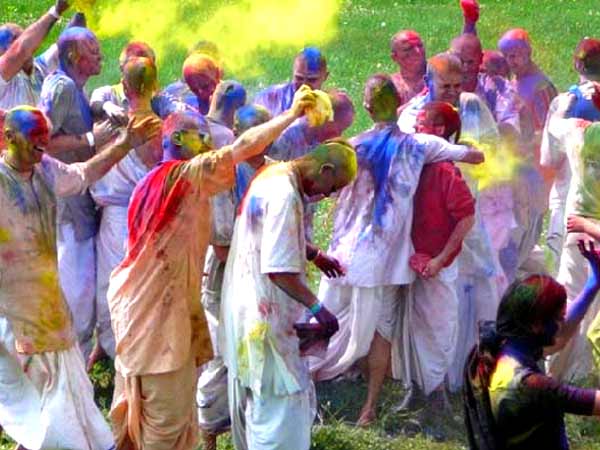The festival of Holi is celebrated with fun and
fervor in India. Explore this article and know all about the
celebrations of Holi in India
Holi Celebrations in India

|
Holi is one of the major festivals of India and
celebrated with immense joy and fervor throughout the country. It is
celebrated in the month of Phalgun according to the Hindu calendar which
commemorates with the month of March in the Gregorian calendar. The date
of Holi is decided according to the Hindu calendar according to which
the date lying on the Phalgun Purnima is considered the day for Holi.
Though the festival is celebrated in most of the parts of the country,
the celebrations have a regional influence in their rituals and
traditions. The celebration of Holi is known as the ‘celebrations
of colors and joys’. Holi starts at midnight with a bonfire of
Holika and the celebrations come to climax in the morning when colors
and music fill the entire atmosphere with zeal of joy and celebrations.
North India
North India is famous for its rough and tough kind of Holi. Legends say
that Lord Krishna spent most of his childhood in Mathura and Vrindavana
and he was the one to introduce the modern form of Holi in this part of
the country. That is why Holi is celebrated with great enthusiasm at
these places for about a week. In North India, the Holi of Mathura and
Vrindavana are specially known for its immense enthusiasm and zeal.
In Mathura and Vridavana, the major temples of the region dedicated to
Krishna and Radha celebrate Holi on a different day. Very similar to
these two places, in most of the North Indian states, Holi means getting
drenched with colored water and gulal. It is considered auspicious as
well as becomes quite enjoyable. The playful teasing by women and
attempts by men to color them with 'gulal' and wet colors from
'pichkari', the attempts to escape and beating the men with sticks to
scamper them away makes Holi very fun filling and enjoyable. These
celebrations are accompanied with scrumptious food and lip smacking
items.
Punjab and Haryana
In Punjab and Haryana, Holi is celebrated in a yet interested way. The
brides of the families hang a pot of buttermilk high up in the streets
and challenge to their brothers-in-law, who try to get to break the pot
by forming a human pyramid. Women try to stop them by beating them with
their saris rolled up as ropes. This mock-drama is staged to commemorate
the playful pranks of child Krishna, who would steal milk, butter and
curd from the maids' houses. In the evening, the brothers-in-law bring
sweetmeats for the women of the house for their contribution in keeping
the family united. The color play also takes place simultaneously.
Western India
Like Haryana, Maharashtra and Gujarat and other states of West India,
also has mock-drama of Krishna trying to break the pots and steal the
butter. Besides, this ‘Matka-breaking ceremony’, men in these
states also takes out several grand processions singing Holi songs and
poems. Soaked with colored water, they walk through the streets and sing
to mock alert the people of the house in the locality to take care of
their pots of butter and milk as Krishna may come in and steal them. At
the time of evening, people visit each others home, exchange sweets and
good wishes.
Eastern India
In eastern state of India, West Bengal has an interesting and different
kind of Holi. In Bengal, Holi is called Dol Yatra (the Swing Festival)
in which idols of Krishna and Radha are placed on swings and devotees
take turns to swing them. Women perform devotional songs and dances
around the swing as men spray colored water and 'Abeer' (colored powder)
on them. However, the tradition is being lost gradually and the modern
trend of playing with colored water and powders in the morning and then
take out processions on the streets with music and drums has also
influenced the Bengali Holi. In Orissa, traditions are similar to that
of Bengal except for the fact that the idols of Jagannath is placed on
the swing here instead of Krishna and Radha, who is believed to be
another form of Krishna. The tradition of sweet exchange, feasting and
color play has also become prominent in the state now.
'Vasanta Utsav' in Shantiniketan
Rabindranath Tagore, the Noble laureate from India, revived Holi as the
Spring festival by introducing 'Vasanta Utsav' in his Shantiniketan or
Bishwabharati University, which is celebrated here in a very special
way. Students and youths dress up in bright colorful dresses such as
yellow and stage a number of cultural programs involving group
choreography, songs and dance followed by playing Holi with 'Abeer'
(colored powder). Today, Vasanta Utsav has become an important part of
the Bengali culture.
North East
If we talk about the North Esatern Holi, the Holi of Manipur is
interesting enough to draw the attention. Holi is a six-day long in
Manipur and commences on the full moon day of Phalguna. In the 18th
century, it merged with the traditional and centuries-old Yaosang
festival of Manipur. In earlier times, there were folk songs and dance
performances under the moonlight accompanied by the indigenous drums.
Today, modern musical instruments have replaced the drums and
fluorescent lamps have replaced the moonlight.
Days before, people collect money from the community for the expenses
on the festivities. A thatched hut of hay, twigs and sticks is built,
only to be set ablaze. Next morning, groups of boys go to play 'gulal'
with the girls and pay them money to get the favor. Devotees play
'gulal', sing devotional songs and dance in front of the Krishna temple
dressed in the traditional white and yellow turban. On the last day of
the festival, a grand procession is taken out to the main Krishna temple
in the capital of Manipur, Imphal where multitude of cultural programs
take place.




